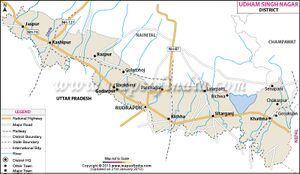Ujen
| Author:Laxman Burdak, IFS (R) |
Ujena (उजेन) is an ancient town in Nainital (now Udham Singh Nagar) district near Kashipur in Uttarakhand.
Contents
Variants
Ujena (उजेन) (जिला नैनीताल) (AS, p.87)
Origin
History
Visit by Xuanzang in 636 AD
Xuanzang visited Govisana in 636 AD. Sir Alexander Cunningham[1] writes that To the south-east of Madawar, at a distance of 400 li, or 67 miles, Hwen Thsang places the kingdom of Kiu-pi-shwang-na, which M. Julien renders by Govisana. The capital was 15 li, or 2½ miles, in circuit. Its position was lofty, and of difficult access, and it was surrounded by groves, tanks, and fishponds.[2] According to the recorded bearing and distance from Madawar, we must look for Govisana somewhere to the north of Muradabad. In this direction the only place of any antiquity is the old fort near the village of Ujain, which is just one mile to the east of Kashipur. According to the route which I marched, the distance is 44 kos, or 66 miles. I estimate the value of the kos by the measured distance of 59 miles between the post-offices of Bareli and Muradabad, which is always called 40 kos by the natives. The true bearing of Kashipur is east-south-east instead of south-east, but the difference is not great, and as the position of Kashipur is just as clearly indicated by the subsequent route to Ahichhatra, I feel quite satisfied that the old fort near the village of Ujain represents the ancient city of Govisana which was visited by Hwen Thsang.
Bishop Hebert[3] describes Kashipur as a "famous place of Hindu pilgrimage which was built by a divinity named Kashi 5000 years ago." But the good bishop was grossly deceived by his informant, as it is well known that the town is a modern one, it having been built about a.d. 1718 by Kashi-nath, a follower
[p.358]: of Raja Devi-Chandra of Champawat in Kumaon. The old fort is now called Ujain ; but as that is the name of the nearest village, it seems probable that the true name has been lost. The place itself had been deserted for several hundred years before the occupation of Kashipur; but as the holy tank of Dron-sagar had never ceased to be visited by pilgrims, I presume that the name of the tank must have gradually superseded that of the fort. Even at the present day the name of Dron-Sagar is just as well known as that of Kashipur.
The old fort of Ujain is very peculiar in its form, which may be best compared to the body cf a guitar. It is 3000 feet, in length from east to west, and 1500 feet in breadth, the whole circuit being upwards of 9000 feet, or rather less than 2 miles. Hwen Thsang describes the circuit of Govisana as about 12,000 feet, or nearly 2½ miles, but in this measurement he must have included the long mound of ruins on the southside, which is evidently the remains of an ancient suburb. By including this mound as an undoubted part of the old city, the circuit of the ruins is upwards of 11,000 feet, or very nearly the same as that given by Hwen Thsang. Numerous groves, tanks, and fish-ponds still surround the place. Indeed the trees arc particularly luxuriant, owing to the high level of the water, which is within 5 or 6 feet of the surface. For the same reason the tanks are numerous and always full of water. The largest of these is the Dron-sagar, which, as well as the fort, is said to have been constructed by the five Pandu brothers for the use of their teacher Drona. The tank is only 600 feet square, but it is esteemed very holy, and is much frequented by pilgrims on their way to the source of the Ganges. Its high bank-s are
[p.559]: covered -with Sali monuments of recent date. The walls of the fort are built of large massive bricks, 15 by 10 by 2½ inches which are always a sure sign of antiquity. The general height of the walls is 30 feet above the fields ; but the whole is now in complete ruin, and covered with dense jangal. Shallow ditches still exist on all sides except the east. The interior is very uneven, but the mass has a mean height of about 20 feet above the country. There are two low openings in the ramparts, one to the north-west and the other to the south-west, which now serve as entrances to the jangal, and which the people say were the old gates of the fort.
The district of Govisana was 2000 li, or 333 miles, in circuit. No king is mentioned, and the country, as I have already noticed, was most probably subject to the Raja of Madawar. It was confined on the north by Brahmapura, on the west by Madawar, and on the south and east by Ahichhatra. It must, therefore, have corresponded very nearly with the modern districts of Kashipur, Rampur, and Pilibhit, extending from the Ramganga on the west to the Shrda or Ghagra on the east, and towards Bareli on the south. With these boundaries the circuit of the district would have been about 290 miles measured direct, or upwards of 300 miles by road distance.
उजेन
विजयेन्द्र कुमार माथुर[4] ने लेख किया है ...उजेन (AS, p.87) उत्तराखंड राज्य के ज़िला नैनीताल में काशीपुर के निकट स्थित एक ऐतिहासिक स्थान है। कनिंघम ने इसका अभिज्ञान गोविषाण से किया है जिसका उल्लेख युवानच्वांग के यात्रावृत में है। उजेन में एक विशाल प्राचीन दुर्ग के ध्वंसावशेष हैं।
External links
References
- ↑ The Ancient Geography of India/Govisana, p.357-358]
- ↑ Julien's ' Hiouen Thsang,' ii. 233. See Map No. X.
- ↑ 'Travels in India,' ii. 246.
- ↑ Aitihasik Sthanavali by Vijayendra Kumar Mathur, p.87
